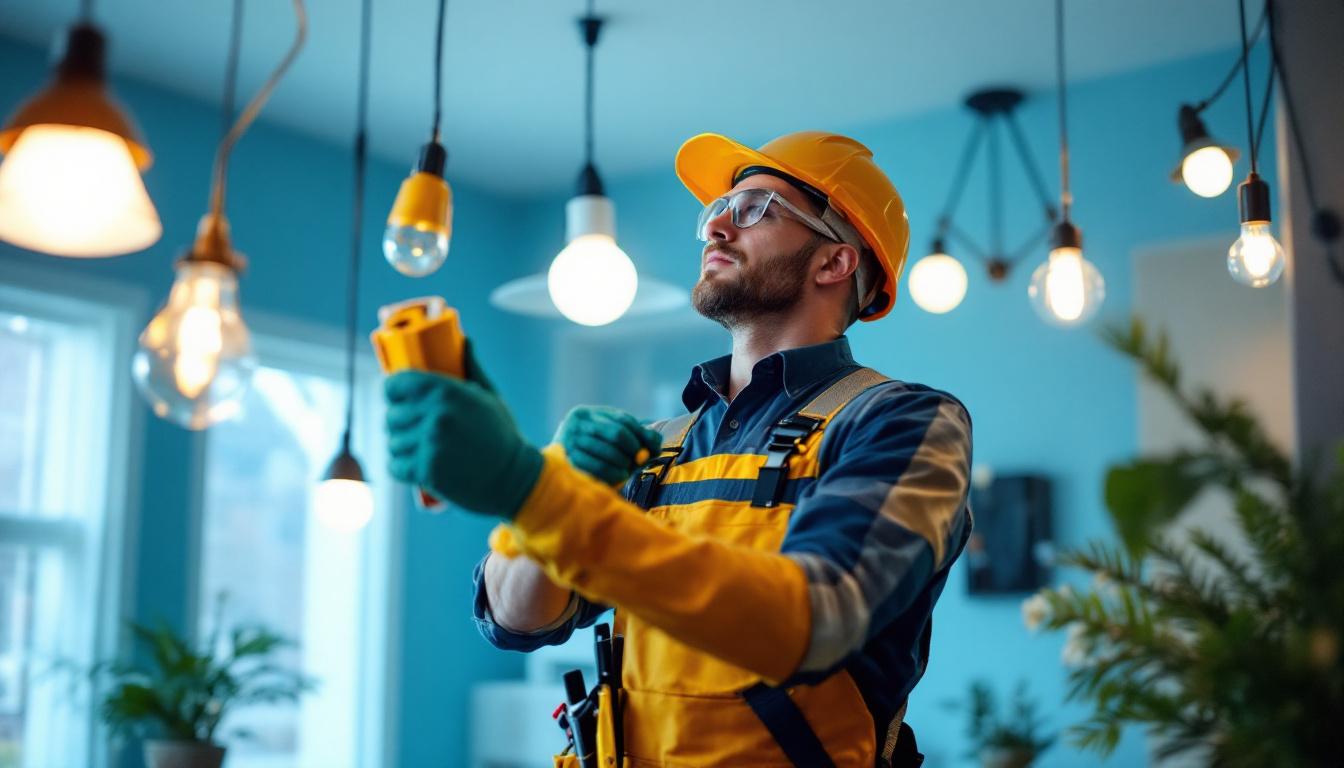
When it comes to lighting installations, especially in commercial and industrial settings, the choice of lighting can significantly impact both functionality and aesthetics. LED shop lights have become the go-to solution for many lighting contractors due to their energy efficiency, longevity, and versatility. However, even experienced professionals can make common mistakes when selecting and installing these lights. This article will explore some of these pitfalls and how to avoid them, ensuring that projects are completed successfully and to the satisfaction of clients.
LED shop lights are designed to provide bright, efficient illumination in various settings, including workshops, garages, and retail spaces. They are available in different styles, such as linear, panel, and high-bay lights, each serving specific purposes. Understanding the unique features and benefits of each type is crucial for making informed decisions.
There are several types of LED shop lights available, each suited for different applications. Linear LED lights are commonly used in workshops due to their long, narrow design, which allows for even distribution of light across work surfaces. Panel lights, on the other hand, are ideal for areas requiring a sleek appearance, such as retail environments. High-bay lights are perfect for warehouses and industrial settings, where ceilings are high and require powerful illumination. Additionally, some manufacturers offer adjustable or modular LED lights that can be customized to fit specific needs, providing flexibility in lighting design.
One of the most significant advantages of LED technology is its energy efficiency. LED lights consume significantly less power than traditional fluorescent or incandescent bulbs, leading to lower electricity bills. Additionally, they have a longer lifespan, reducing the frequency of replacements and maintenance costs. This longevity is particularly beneficial in commercial settings where downtime can be costly. Moreover, LED lights emit less heat compared to their incandescent counterparts, which can contribute to a cooler environment, further enhancing comfort and productivity in workspaces.
LED shop lights are versatile and can be used in various applications. In garages, they provide bright lighting for tasks such as vehicle repairs and maintenance. In retail spaces, they enhance product visibility and create an inviting atmosphere. Furthermore, in industrial settings, they improve safety by ensuring adequate lighting in work areas. Beyond these common uses, LED shop lights are also increasingly being adopted in home settings, such as basements and attics, where bright, efficient lighting can transform underutilized spaces into functional areas for hobbies or storage. Additionally, their durability makes them suitable for outdoor applications, such as illuminating patios or workshops, ensuring that activities can continue even after sunset.
While the advantages of LED shop lights are clear, lighting contractors often encounter several common mistakes during the selection and installation process. Identifying these pitfalls can help avoid costly errors and ensure that clients receive the best possible lighting solutions.
One of the most frequent mistakes is underestimating the light output needed for a specific space. Each area has unique lighting requirements based on its size, purpose, and the tasks being performed. Failing to conduct a thorough lighting assessment can result in inadequate illumination, leading to safety hazards and reduced productivity.
To avoid this mistake, it is essential to understand the concept of lumens, which measure the total amount of visible light emitted by a source. Different tasks require different lumen levels; for example, a workshop may need around 300-500 lumens per square meter, while a retail space may require 500-1000 lumens per square meter. Conducting a lighting audit can help determine the appropriate lumen levels for each area. Additionally, it is beneficial to consider the reflectivity of surfaces within the space, as lighter colors can enhance light distribution, while darker colors may absorb more light, necessitating higher lumen output to achieve the desired brightness.
Color temperature is another critical factor that lighting contractors often overlook. Measured in Kelvin (K), color temperature influences the ambiance and functionality of a space. For instance, a cooler color temperature (above 5000K) is suitable for workspaces where precision is essential, while warmer temperatures (below 3000K) create a cozy atmosphere in residential settings.
Choosing the wrong color temperature can affect the overall mood and productivity of a space. It is crucial to consider the intended use of the area and select an appropriate color temperature that aligns with the client’s preferences and needs. Moreover, the integration of adjustable color temperature options, such as tunable white lighting, can offer versatility, allowing spaces to adapt to different activities throughout the day. This flexibility can enhance user experience and satisfaction, making it a valuable consideration for modern lighting design.
Fixture placement is paramount to achieving optimal lighting. Placing lights too far apart can create dark spots, while overcrowding fixtures can lead to glare and discomfort. Lighting contractors must carefully plan the layout of fixtures to ensure even illumination throughout the space.
Utilizing lighting design software can assist in visualizing the placement and effectiveness of fixtures before installation. Additionally, considering the height of ceilings and the specific tasks being performed in each area will help in determining the ideal fixture placement. It is also important to take into account the layering of light; combining ambient, task, and accent lighting can create a more dynamic and functional environment. For example, in a kitchen, overhead fixtures can provide general illumination, while under-cabinet lights can enhance task lighting for food preparation, ensuring that every corner of the space is well-lit and inviting.
Selecting the right LED shop lights involves more than just picking a model off the shelf. Several factors should be taken into account to ensure that the chosen lights meet the specific needs of the project.
Energy efficiency is a key consideration when selecting LED shop lights. Look for products with high lumen-per-watt ratios, as these will provide more light output for less energy consumption. Additionally, consider lights with Energy Star ratings, as they meet strict efficiency guidelines and can help clients save on energy costs. Beyond just the initial purchase price, energy-efficient lighting can lead to significant savings over time, making it a wise investment for both residential and commercial spaces. Moreover, many utility companies offer rebates for energy-efficient lighting upgrades, further incentivizing the switch to LED technology.
The durability of LED shop lights is essential, especially in industrial environments where they may be exposed to harsh conditions. Look for lights with sturdy construction, such as those made from aluminum or high-quality plastics. Additionally, consider the IP rating, which indicates the level of protection against dust and moisture. A higher IP rating ensures that the lights can withstand challenging conditions. In addition to physical resilience, consider the thermal management of the lights; effective heat dissipation can prolong the lifespan of LEDs, reducing the frequency of replacements and maintenance. This is particularly important in high-temperature environments where overheating can lead to premature failure.
When selecting LED shop lights, it’s important to consider the warranty and customer support offered by the manufacturer. A good warranty indicates confidence in the product’s quality and can provide peace of mind for both contractors and clients. Additionally, reliable customer support can be invaluable for troubleshooting and addressing any issues that may arise during installation or use. It’s also beneficial to research the manufacturer’s reputation in the industry; companies with a history of positive customer feedback are more likely to provide the support needed for a successful lighting project. Furthermore, some manufacturers offer installation assistance or guides, which can be a great resource for those unfamiliar with LED lighting systems.
Proper installation is crucial for maximizing the benefits of LED shop lights. Following best practices can help ensure that the lighting system functions optimally and meets the client’s expectations.
Wiring is a critical aspect of lighting installation. Using the correct gauge wire and ensuring secure connections can prevent electrical issues and ensure safety. It is essential to follow local electrical codes and regulations to avoid potential hazards.
Additionally, consider using dedicated circuits for high-wattage LED fixtures to prevent overload and ensure consistent performance. This practice not only enhances safety but also prolongs the lifespan of the lighting system.
After installation, it is important to test the lighting levels to ensure they meet the desired specifications. Use a light meter to measure the illumination in various areas and make adjustments as necessary. This may involve repositioning fixtures or adjusting the dimming settings to achieve the optimal lighting environment.
Once the installation is complete, providing clients with education on the use and maintenance of their new LED shop lights is essential. Explain the benefits of energy-efficient lighting, how to adjust settings, and the importance of regular maintenance. This knowledge empowers clients to make the most of their investment and ensures long-term satisfaction.
LED shop lights offer numerous advantages for commercial and industrial lighting applications. However, lighting contractors must be aware of common mistakes that can hinder the effectiveness of these systems. By understanding the importance of light output, color temperature, fixture placement, and proper installation techniques, contractors can provide clients with optimal lighting solutions that enhance functionality and aesthetics.
By avoiding these pitfalls and adhering to best practices, lighting contractors can ensure that their projects are completed successfully, resulting in satisfied clients and a positive reputation in the industry. The right LED shop lights, combined with careful planning and execution, can transform any space into a well-lit, efficient environment.
Ready to avoid common lighting mistakes and elevate your projects with the best LED shop lights in the industry? At LumenWholesale, we provide lighting contractors like you with spec-grade lighting products that combine quality, affordability, and convenience. Say goodbye to inflated markups and hello to our extensive selection of reliable, high-performance lighting—delivered directly to you with free shipping. Make your next lighting project a shining success and experience the unbeatable value of wholesale lighting. Wholesale Lighting at the Best Value is just a click away.

Discover how choosing the best warehouse lighting can enhance efficiency, safety, and productivity.

Discover proven methods for lighting contractors with Light Hang.

Discover innovative hacks for smart lighting contractors using LED work lights.

Discover why lighting contractors should prioritize large shop fans in their projects.